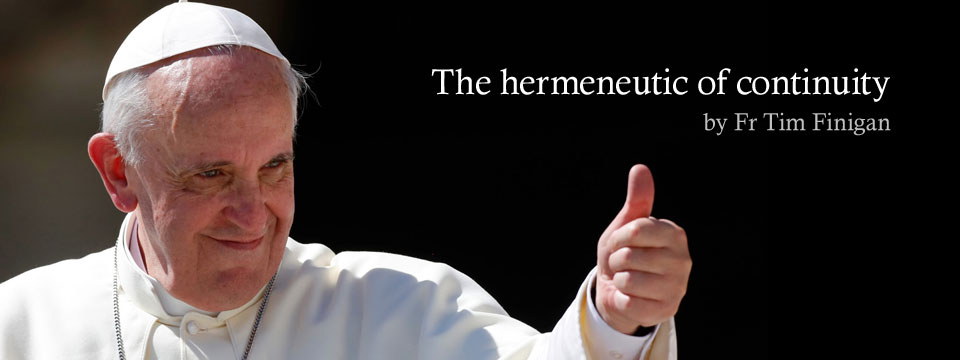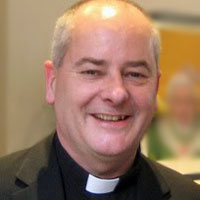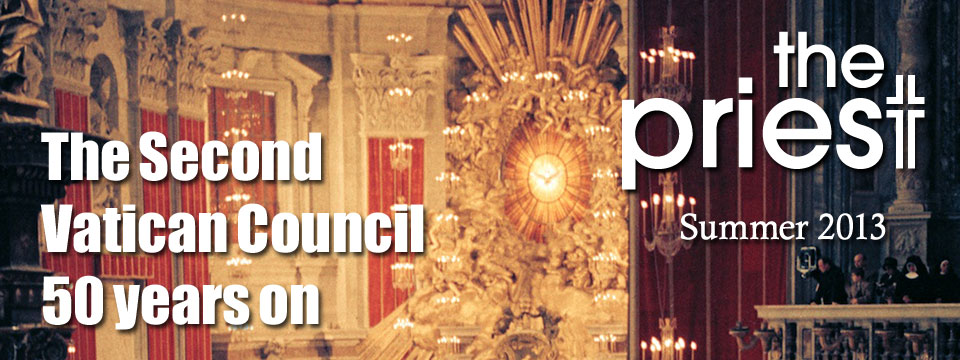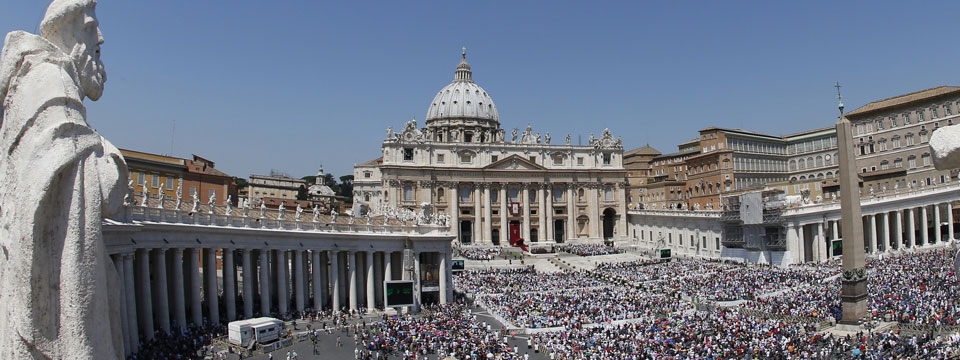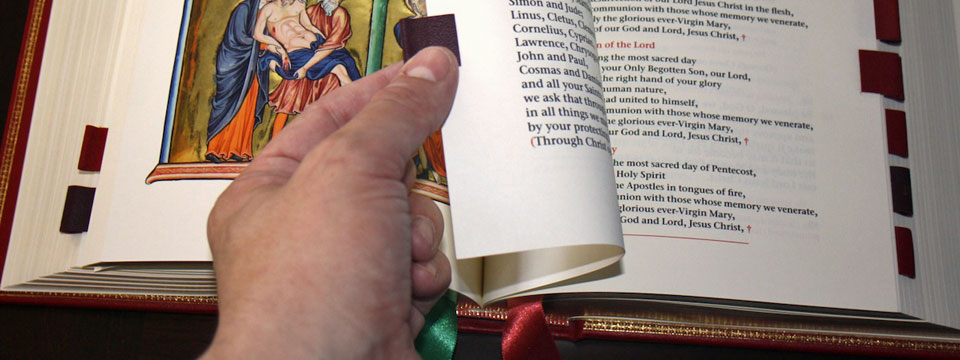- Vatican II and its context.
- Trent and Vatican II: compared (not contrasted).
- The hermeneutic of continuity.
- Church, Sacrament, and the People of God.
It is perhaps worth noting that since Fr Finigan presented this paper, Pope Francis has paid tribute to historian Agastino Marchetto. Archbishop Marchetto is the chief critic of the ‘Bologna School’ which proposes a hermeneutic of rupture in its account of the Council. Archbishop Marchetto, in contrast, is one with Benedict in his hermeneutic of organic continuity. Writes Pope Francis:
“I once told you, dear Archbishop Marchetto, and today I repeat it, that I consider you the best hermeneutical interpreter of the Second Vatican Council.”
An approach to controversial texts of the Council
When I began writing my blog The Hermeneutic of Continuity in April 2006, I had been attracted by what seemed like a good idea for evangelisation, and indeed a medium for various short articles on matters of interest to Catholics. I had recently read Pope Benedict’s December 2005 address to the Roman Curia in which he spoke of the manner of interpreting the second Vatican Council. Pope Benedict XVI is a man who combines intelligence and scholarly expertise, with originality of thought. His 2005 address showed all three qualities in approaching the confusion and damage that had afflicted the Church since Vatican II. He provides a brilliant way out of the morasse.
What is the “hermeneutic of continuity”?
The study of philosophical hermeneutics originated with the work of Heidegger and Hans Georg Gadamer who provided the foundation in his book Warheit und Methode (Truth and Method). I do not intend to explore this area of philosophy except to draw attention to Gadamer’s position that the human person never enjoys absolute neutrality in relation to the realities which surround him. We are affected by pre-existing concepts and traditions, and previous experiences, whether consciously or not. In the present situation in the Church it is important for us to understand this in relation to our own priestly formation. It is possible that while remaining orthodox, we may have imbibed some aberrant spiritual ideas without realising it. I have been conscious of this in my own priestly development.
The philosophy of hermeneutics was influential in Germany and perhaps this is why Pope Benedict expressed himself in this particular way. A hermeneutic in the singular, refers to a particular method or strand of interpretation and this is what is important for us. Thus we could say that “hermeneutic” in our context means “principle of interpretation.”
In his address to the Roman Curia in December 2005, Pope Benedict spoke of two ways of understanding the second Vatican Council. One way is to see a radical split between the pre-conciliar Church and the post-conciliar Church. According to this hermeneutic of rupture, the texts of the council need to be seen in terms of a “spirit of Vatican II” which goes beyond the texts themselves to foster innovation in the Church and a departure from the past. The other way is to understand the Council as concerned with the reform of the Church (which must always be reformed) and in continuity with the whole tradition of the Church. In the address to the Roman Curia, the Holy Father explained it thus:
there is the “hermeneutic of reform”, of renewal in the continuity of the one subject-Church which the Lord has given to us. She is a subject which increases in time and develops, yet always remaining the same, the one subject of the journeying People of God.
Those of us who speak of the “hermeneutic of continuity” are sometimes criticised for failing to take account of this fuller expression, of failing to appreciate the importance of the reform and renewal of which Pope Benedict speaks. Let us first demolish one scruple. Pope Benedict himself used the same shorthand in his Apostolic Exhortation Sacramentum Caritatis. The Holy Father spoke of the need to avoid artificial discontinuities in the Liturgy and explained in a footnote:
I am referring here to the need for a hermeneutic of continuity also with regard to the correct interpretation of the liturgical development which followed the Second Vatican Council.{{1}}
He has since used the same shorter designation in an another address.
Just as the hermeneutics of continuity are proving ever more urgent for a satisfactory understanding of the Second Vatican Council’s texts, likewise a hermeneutic we might describe as “of priestly continuity” appears necessary.
However, we do need to understand the hermeneutic of continuity in terms of reform and renewal. Indeed the whole point of Pope Benedict’s address to the Roman Curia was to point the Church in the right direction when considering reform and renewal since there had been attempts at reform which were based on a radical discontinuity with the past. Rather than speaking about these things generally, I would now like to look at the way in which such a hermeneutic of continuity can be applied in the life of the Church.
Applied to the liturgy
Perhaps the most visible result of Pope Benedict’s key idea is to be seen in the Sacred Liturgy. For the ordinary Catholic, the most visible change after the Council was in the Sacred Liturgy. Latin was done away with, choirs sang popular tunes instead of Gregorian Chant, lay people started giving out Holy Communion (for which people began to stand rather than kneel), and most striking of all, the priest faced the people throughout the Mass.
People are surprised to discover that not a single one of these changes was actually called for in the Sacred Constitution on the Sacred Liturgy of Vatican II, or in fact in the official version of the Roman Missal, the Missale Romanum promulgated in 1970 and revised in 2000. Each of these changes has been challenged by the practice of Pope Benedict and by Pope Francis at Masses that they have celebrated as Pope. The music at such Masses is now generally Gregorian Chant or polyphony; communicants coming to Pope Benedict were given Holy Communion kneeling at a prie-dieu and on the tongue, and several times, Pope Benedict celebrated Mass, notably in the Sistine Chapel, not as some would say “with his back to the people”, but facing towards the East. Although Pope Francis has a different approach to the liturgy in some respects, he has not contradicted the practice of Pope Benedict as some expected him to do. For example, the insistence on Holy Communion on the tongue is reinforced by his practice of giving Holy Communion by intinction and by the instruction to priests that they should give Holy Communion to the people on the tongue rather than on the hand.
For some people, these developments are confusing and seen as “going backwards” or even as a repudiation of Vatican II. That is why it is important first of all to know what Vatican II said and didn’t say, and secondly to understand that Vatican II should not be seen as a break with the Church’s past but as a reform undertaken in continuity with the whole tradition of the Church.
The examples I have given are illustrative, but of course they are controversial, and may distract us from the principal theme. Let us return then to a central question and ask what Vatican II did say about the Liturgy. The Council saw the Sacred Liturgy as an exercise of the priestly office of Christ:
[…] every liturgical celebration, because it is an action of Christ the priest and of His Body which is the Church, is a sacred action surpassing all others; no other action of the Church can equal its efficacy by the same title and to the same degree.{{2}}
The council went on to say:
In the earthly liturgy we take part in a foretaste of that heavenly liturgy which is celebrated in the holy city of Jerusalem toward which we journey as pilgrims, where Christ is sitting at the right hand of God, a minister of the holies and of the true tabernacle; we sing a hymn to the Lord’s glory with all the warriors of the heavenly army; venerating the memory of the saints, we hope for some part and fellowship with them; we eagerly await the Saviour, Our Lord Jesus Christ, until He, our life, shall appear and we too will appear with Him in glory.{{3}}
Famously also, the Council referred to the Sacred Liturgy as source and summit:
[…] the liturgy is the summit toward which the activity of the Church is directed; at the same time it is the font from which all her power flows.{{4}}
Notice that the liturgy is not simply the source and summit of the daily life of the Christian but of the whole activity of the Church.
Nevertheless, almost immediately, there was a drive for innovation in the Liturgy, the insertion of new altars facing the people, the celebration of the whole of the Mass in the vernacular, and various experiments in Liturgy. In due course, the new order of Mass was produced, and subjected to criticism by some senior figures in the Roman Curia, but welcomed by many as a new Mass.
In due course, the rites for the other sacraments were revised, official translations were produced, and a status quo developed in which the standard form of Mass that most people experienced in the Church was one in which the priest faced the people, spoke only in the vernacular, and generally tried to engage in a conversational way with people. Music was drawn from a range of sources: Catholic and non-catholic hymns, new compositions for the guitar, clapping songs for children, and sometimes parodies of popular songs with religious words added. The use of Gregorian chant, and indeed the singing of the actual texts of the Introit, Gradual, Offertory and Communion disappeared except for the relatively esoteric environment of some monasteries. The mutual enrichment envisaged by Pope Benedict, has gradually taken place. In my own parish, for example, the sung English Mass is progressively including the singing of the texts of the Mass rather than simply singing hymns at various points.
The Council envisaged some limited reforms in the rite of Mass. Within a few years, there was a wholly new rite of Mass which is now the ordinary form according to which Mass is celebrated in the Roman Rite. What happened almost immediately was a strong antipathy to the past. The so-called “Tridentine Mass” was seen very much as the preserve of extremists who were opposed to the Council. Not only that, even in the modern rite, any use of Latin, facing eastwards, singing of the Mass texts themselves, or even the use of fine vestments and vessels, which were routinely replaced by polyester creations and pottery is regarded with suspicion. Any use of traditional materials, texts, music or gestures came to be reprobated.
From the very beginning of the liturgical reform, the Church issued documents representing an almost continual correction of abuses. The latest major document of this type was Redemptionis Sacramentum in 2004, although there have been many other minor statements and injunctions issued to correct abuses in the Liturgy which continue largely unabated in many places. When Redemptionis Sacramentum was published, I suggested in Faith Magazine that an effective way of reforming the Liturgy would be to give permissions rather than issue prohibitions that were widely ignored. Giving permission to orthodox priests to use more sacral and more traditional elements in the Liturgy would enable them to engage in the reform of the liturgy without fear of sanctions from their own superiors.
Pope Benedict has had the courage and vision to do this in the most radical way possible by declaring, as supreme legislator, that the older form of the Roman rite was not abrogated and therefore in principle always permitted. He made a watertight legal enactment that established that priests do not need permission to celebrate Mass in the older form. For the effects of the Motu Proprio: Summorum Pontificum, see the Catholic Blogosphere – passim.
What has happened is that the centre of gravity has shifted. Pope Benedict spoke of a mutual enrichment which can be seen at many conferences and gatherings of Catholics who agree on the essentials of the faith, on the importance of the Blessed Sacrament, and devotion to Our Lady. A Reform of the Reform will help us to rediscover the beauty of the Sacred Liturgy and the adoration that is at the heart of it:
Here is the reason why everything in the liturgical act, through the nobility, the beauty, and the harmony of the exterior sign, must be conducive to adoration, to union with God: this includes the music, the singing, the periods of silence, the manner of proclaiming the Word of the Lord, and the manner of praying, the gestures employed, the liturgical vestments and the sacred vessels and other furnishings, as well as the sacred edifice in its entirety.{{5}}
I think that this process will continue to the great good of the Church.
Applied to catechesis
In catechetics, we might present Catholic teaching to children in a way that uses examples from modern life, that relies less on memorisation, or relates more closely to scripture. What we cannot do is to present catechesis as something now radically changed, in which we no longer memorise anything, in which we do not teach about angels any more, or in which everything begins with human experience rather than the gospel of Christ.
We can certainly learn from educators about different ways to present material effectively to different age groups of children or to adults, though we should not accept uncritically whatever happens to be the latest educational fad. For some time, the concept of “discussion groups” was seen as an essential part of adult education, but in fact, many adults find this form of education or training uncomfortable or, in some cases, a waste of their time. I remember once attending an evangelical presentation where the organisers had realised this: on the publicity materials, they included a note saying that in order not to deter newcomers, there would be no small group work.
What happened in some cases was that the advocacy of new methods of teaching was in fact more to do with new content, or even no content at all. The idea of catechesis by sharing one’s “faith story” replaced the teaching of the doctrine of the faith so that in some groups there was little more than a pooling of shared ignorance. An example of the type of thing I am talking about is to be found in one book which was popular among catechists as a kind of source for policy:
‘Education, to be true to its nature, cannot tell people what to believe: all it can do is to say what people do believe. (…) Hence the classroom is not the right setting for deliberately evangelising pupils nor is it the place where catechesis normally occurs.’
Significantly this statement is not prefaced in the book by “the author believes”; it is given as a categorical statement.
Such an experience-based approach continues in many schools and parishes and is a rupture with the past. If we are to use new methods of catechesis, they must always be based on the pillars of the faith, the Creed, the Sacraments, the Commandments and Prayer. One good example of this in England is the excellent programme Evangelium, developed by Frs Marcus Holden and Andrew Pinsent, which uses modern media to present the faith in an attractive way: but it is the faith that is presented, in all its fullness.
Applied to moral teaching
One area in which rupture with our tradition has been most evident is in the teaching of moral theology. It is easy to ridicule the old manuals with their lengthy discussions concerning the Eucharistic fast or Friday abstinence, or what exactly constitutes the misuse of the marriage act. Laugh though we may, I can say from my own experience of writing a column called “Catholic Dilemmas” for the Catholic Herald in England, that people do ask questions about these things. They want to know what is right and wrong in practice, not just in theory. We do need to guard against scrupulosity but arguably the greater problem is laxism and the idea that we can all simply make up the rules as we go along. As the older manuals underlined as a basic truth, we are affected by original sin in our judgement as well as our desires, and we will tend to invent excuses to make life easier.
The most damaging trends in moral theology were those ideas that replaced objective moral norms with subjective or proportionalist systems whereby any behaviour could be excused with reference to a higher internal motivation – perhaps “love.” The idea of the fundamental option was effectively misused so as to prevent anyone from ever being guilty of a mortal sin. Blessed Pope John Paul’s Veritatis Splendor was a tidemark in the post-conciliar counter-reformation because it re-asserted the thomistic doctrine of natural law,{{6}} its universality and immutability,{{7}} the possibility of an erroneous conscience,{{8}} and crucially, that:
It is possible that the evil done as the result of invincible ignorance or a non-culpable error of judgment may not be imputable to the agent; but even in this case it does not cease to be an evil, a disorder in relation to the truth about the good.{{9}}
It is significant that in that encyclical, Blessed Pope John Paul reminded us that he announced his intention of writing it in his Apostolic Letter Spiritus Domini, of 1 August 1987: on the second centenary of the death of Saint Alphonsus Liguori.
In practice, the recovery of continuity with the tradition of moral theology, especially with reference to the great writers such as St Alphonsus, will involve a recovery of the concept of mortal sin. Even today this is not popular as my postbag (or nowadays email inbox) shows whenever I mention the subject. When continuity with traditional teaching is lost, people easily pick up on popular caricatures of that tradition such as the sermons on hell in James Joyce’s Portrait of the Artist as a Young Man. The penny catechism related very simply the teaching of the Council of Trent that a person who has committed a mortal sin may return to grace (but not Holy Communion) if they make an act of perfect contrition, even before they have made a sacramental confession. We are not saying that everyone who commits a mortal sin goes to hell if they have not been able to get to confession. The Cure of Ars understood this and preached it: it was a part of routine catechesis. Yet for some time people have assumed that it is impossible to commit a mortal sin; the assumption is motivated by the reluctance to entertain the possibility of anyone putting themselves in danger of hell. Paradoxically this optimism concerning human freedom from serious sin is tied in with a radical pessimism about both the mercy of God and the possibility of co-operating with that mercy by a genuine act of sorrow out of the love of God.
This consideration of sin is closely related to a further area of rupture, that of which I spoke yesterday, concerning the spiritual life and our rich Catholic tradition of ascetical and mystical theology.{{10}} In that paper, I focussed particularly on the priestly life but the recovery of our tradition of spiritual teaching is an essential part of our ministry as priests in guiding lay people to greater holiness.
Difficult Questions
Dignitatis Humanae concerned with religious freedom in society, the right of people to follow their conscience and to worship and not to be forced to act against their conscience.
Religious freedom, in turn, which men demand as necessary to fulfil their duty to worship God, has to do with immunity from coercion in civil society. Therefore it leaves untouched traditional Catholic doctrine on the moral duty of men and societies toward the true religion and toward the one Church of Christ. Over and above all this, the council intends to develop the doctrine of recent popes on the inviolable rights of the human person and the constitutional order of society.{{11}}
In fact, the Church never claimed the right to coerce the non-baptised. The forced baptism of Jews was condemned and in Spain after the reconquista, the inquisition concerned itself with those who are baptised. Indeed, the Church retains coercive power over the baptised, as we see for example in the case of priests who have committed offences against minors. Not only are they subject to ecclesiastical censures but they are, quite properly “handed over to the secular arm.”
Blessed Pius IX condemned the erroneous idea that:
Liberty of conscience and worship is each man’s personal right, which ought to be legally proclaimed and asserted in every rightly constituted society; and that a right resides in the citizens to an absolute liberty, which should be restrained by no authority whether ecclesiastical or civil, whereby they may be able openly and publicly to manifest and declare any of their ideas whatever, either by word of mouth, by the press, or in any other way.{{12}}
This is not a contradiction: Dignitatis Humanae did not proclaim an absolute liberty of conscience unrestrained by the rule of law.
On ecumenism, the prudential judgement of the Church in Unitatis Redintegratio differed from Mortalium Animos of Pius XI in 1925. Pius XI forbade Catholics from taking part in ecumenical assemblies and from any communicatio in sacris. Vatican II allowed some sharing in worship and prayer, and dialogue with the purpose of achieving unity and the bond of unity, charity and peace.
On Collegiality, Vatican II reaffirmed that the College of Bishops has no authority unless together with the Roman Pontiff who has full, supreme, and universal power which he is always free to exercise. The explanatory note made it clear that the College of Bishops is not a college in a strictly juridical sense of a group of equals who entrust power to a president, but in a scriptural sense because Christ called Peter and the apostles together as a group.
Applied to our catholic ethos
The attitude “we have done away with all that old stuff” was, it must be admitted, quite common in the recent past. The contrast between a bad world before the Council and a brave new world after it, was a strong motif in theology, morals and spiritual teaching. For Pope Benedict to correct this attitude is therefore a major reform within the Church and it can prove to be painful for some people who remember with enthusiasm the atmosphere of the sixties and seventies when it seemed that everything was changing for the better. In practice, the people who complain most bitterly about changes made by young orthodox and traditional priests are likely to be those who were teenagers or young adults during the immediate aftermath of the second Vatican Council. They remember the heady days of folk Masses and priests in jeans for the first time: the exciting sense that the Church was entering a new era. In fact, as we know, all was not sweetness and light. Every measurable statistic of Church life plummeted, from Mass attendance, to baptisms, to marriages, to ordinations; and at the same time, many religious and priests left their order or left the priesthood, and many dioceses in the West are facing the problem of planning for the closure of Churches and parishes.
On the positive side, one of the effects of Pope Benedict’s hermeneutic of continuity is the removal of inhibitions about those things that are beautiful and unashamedly Catholic. Certainly this began with Blessed Pope John Paul, the new movements, the rediscovery of the sacrament of confession at Youth Days, adoration of the Blessed Sacrament in parishes, and organisations that essentially promote orthodox moral and doctrinal teaching being seen as more mainstream. Pope Benedict provided a major impetus with Summorum Pontificum which brought respectability to many traditional groups which had hitherto been considered extreme. This has helped to shift the centre of gravity not only with respect to the Liturgy but also with respect to the doctrine, and moral and spiritual teaching.
Pope Francis, in his teaching, has focussed especially on that purity of evangelical focus which is essential for the credibility of the Church in our time. Although he has not made the ars celebrandi of the liturgy a priority in the way that Pope Benedict did, we perhaps fail to notice that the papal liturgies have retained that sense of the sacred which Pope Benedict stamped upon them, both in reverence and in the promotion of liturgical music. Notably, despite the urgings of some (particularly some Italian Bishops) Pope Francis has made it clear that he wishes us to treasure tradition alongside innovation. In practical terms, he has resisted calls to replace Mgr Guido Marini, the Papal MC.
The concept of the hermeneutic of continuity is of urgent importance in those formerly Catholic countries that are beginning to experience some of the disintegration that happened in England decades ago, and in Ireland more recently. It is hard to convince faithful Catholics in those countries that they too may see a falling-away of faith, theologians questioning basic doctrine, attacks on the teaching of Humanae Vitae, widespread lapsation, divorce, the relentless emptying of seminaries, and routine cohabitation before or instead of marriage. It is heartbreaking to see some priests offering the same remedies that failed us years ago and are now painfully visible on YouTube: those rock Masses with priests on the sanctuary clapping along (hint: they are not laughing with you, they are laughing at you.) Recently I heard from an excellent group in England who are working in schools and with confirmation groups. They take for granted nowadays after all our experience that youth work must be faith-based and involve catechesis. It is sad to see others seemingly unable to realise this – they could skip thirty years of failed experiments. Let us pray that the new opportunities of social networking can make this change happen faster.
Sacred and Great
In Summorum Pontificum, Pope Benedict said:
“What earlier generations held as sacred, remains sacred and great for us too, and it cannot be all of a sudden entirely forbidden or even considered harmful. It behoves all of us to preserve the riches which have developed in the Church’s faith and prayer, and to give them their proper place.”{{13}}
He was speaking of the Sacred Liturgy but his words apply to catechetics, to morals, to the spiritual life, and to our Catholic ethos generally. “What earlier generations held as sacred, remains sacred and great for us too.”
As I have tried to stress, Pope Francis does not stand in contradiction to this. Nobody can in fact go back to the past, whether it is the past of Pius XII or Paul VI. We build on the work of our predecessors who have changed the world, and certainly blessed John Paul and Pope Benedict changed the world. Pope Francis, faced by scandals not only within the priesthood at large but within the Vatican itself, has chosen especially to emphasise the basic human values of charity and compassion, especially to the poor of the Lord who come to us for the solace which Christ gives.
On this point should never give in to the idea that compassion is the preserve of those liberals who reject the Church’s doctrinal and moral teaching. In fact, genuine compassion is based on the truth, not on a counterfeit gospel which takes the uncompromising teaching of Christ out of the scriptures. Our Lord was explicit about the power of Satan, and so is Pope Francis. Pastoral charity to others is not a function of our own desire to be accepted but is based on the truth of Christ which sets us free.
That same truth of Christ can lead us to genuine ecumenism. In many countries, Christians have been united in opposing the legalisation of same-sex marriage and in defending the right of Christians to a presence in the public square. We do not agree on all matters, though it is interesting to see how many evangelical Christians are thoughtfully considering the teaching of Humanae Vitae and Blessed John Paul’s theology of the body. There was a time when all Christians shared this outlook on human life without question. An important task of ecumenism is to present this teaching as something that is part of the tradition shared by all Christians until the early 20th century.
Naturally, this is also an area in which inter-faith dialogue can flourish. Many schools misguidedly present the different major world religions as though they were all the same. It would be an engaging project to give a brief summary of those areas in which we differ from other faiths, and those areas in which we share values. Obviously we do not believe that the Koran is inspired or that Mohammed is a prophet. However we do believe along with Muslims in the sanctity of life and the family. Similar observations could be made with respect to Hinduism and Buddhism. We can be clear that we differ on essential matters of faith, but again we agree on the sanctity of human life and the family. If we were able to harness this basic agreement, it might well give some governments food for thought.
After what we might call the mature disintegration of Church life in England and Western Europe, Australia and the USA, there is a new hope which is especially seen in the young. I have the privilege of teaching seminarians Sacramental Theology (the poor chaps have to face me at nine o’clock on a Monday morning) and I am inspired by the quality of the young men coming forward for priestly training. The same is true of the young people who asked me if they could set up a new Faith Group in the parish. They want to hear clear teaching on the basics of faith and morals, but their questions these days are sharper and more urgent. They interact with their peers through social networking and through real networking, they are asked searching questions about the historicity of the gospels, the existence of God, the relationship between science and religion, the Catholic Church’s teaching on homosexuality and a host of other hot-button issues. They want clear and coherent answers, not just because they are trying to be clever and trip up the priest but because they want to go out and give answers to their friends.
They are in the vanguard of the new evangelisation; they are already doing it and we need to catch up. They know that humanly speaking it is a hopeless cause in our radically secularist society. One thing I thank God for is the popularisation of the fables of Tolkien and CS Lewis – I do think that they believe in the way that only the young can with real enthusiasm, that it is worth fighting for a cause that is hopeless in human terms because “If God is for us, who can be against us?”
Those young people who are still part of the Church are not there for social reasons or because their parents have forced them to come. They have the faith and they look to us as priests to be like the wise steward who brought out from his storeroom things both old and new. We have access to a wealth of tradition from St Peter and the apostles, the great Fathers of the Church, St Thomas and the saintly theologians of his era, the saints and heroes of the counter-reformation and yes, the Popes of recent times. We have an enormously rich treasure to share with others. Let us embrace it ourselves and hand it on faithfully to a new generation.
[[1]]Pope Benedict XVI. Address to participants in the Conference organised by the Congregation for the Clergy. 12 March 2010.[[1]]
[[2]]Sacrosanctum Concilium n. 7.[[2]]
[[3]]Sacrosanctum Concilium n. 8.[[3]]
[[4]]Sacrosanctum Concilium n. 10.[[4]]
[[5]]Mgr Guido Marini.[[5]]
[[6]]Veritatis Splendor n. 44.[[6]]
[[7]]Veritatis Splendor n. 51.[[7]]
[[8]]Veritatis Splendor n. 62.[[8]]
[[9]] Veritatis Splendor n. 63.[[9]]
[[10]] Lecture: “Trent and Vatican II compared (not contrasted).”[[10]]
[[11]] Dignitatis Humanae n.1 “Porro, quum libertas religiosa, quam homines in exsequendo officio Deum colendi exigunt, immunitatem a coercitione in societate civili respiciat, integram relinquit traditionalem doctrinam catholicam de morali hominum ac societatum officio erga veram religionem et unicam Christi Ecclesiam. Insuper, de hac libertate religiosa agens, Sacra Synodus recentiorum Summorum Pontificum doctrinam de inviolabilibus humanae personae iuribus necnon de iuridica ordinatione societatis evolvere intendit.”[[11]]
[[12]] Bl. Pius IX. Quanta Cura. n. 3.[[12]]
[[13]] Pope Benedict XVI. Letter to the Bishops of the World. 7 July 2007.[[13]]

